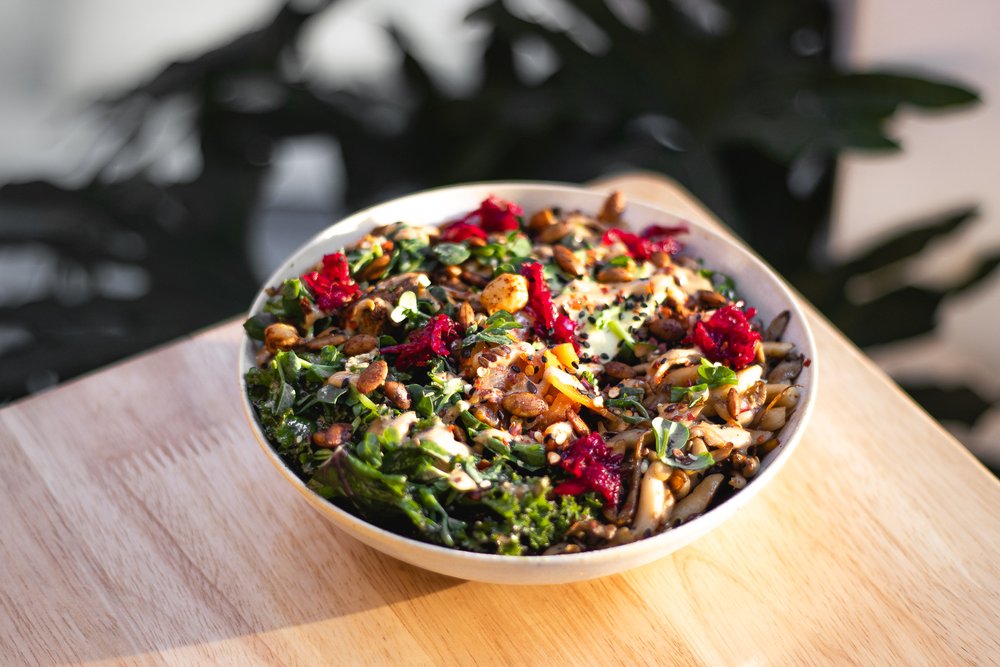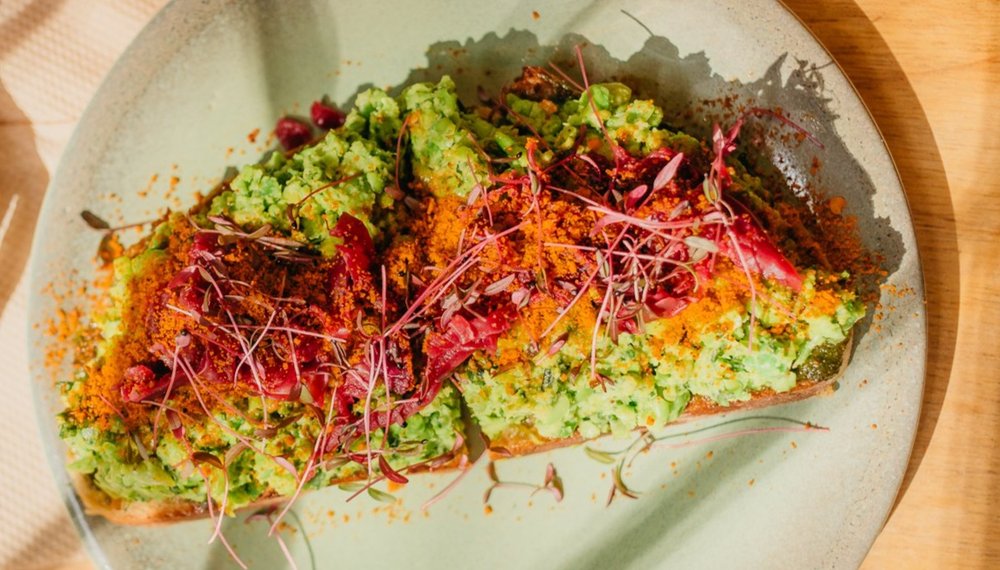
To recap from the last few weeks- we first talked about being more mindful of the food that we put into our bodies, and gave you some tips on how to eat slowly and consciously, chewing carefully to ensure we eat when we are hungry and stop when we are full. We then went on to talk about adding more colour into our diets through eating a rainbow of plants and some simple, action-oriented advice to help you to do this.
In order to help you move towards your healthiest self, you need to understand which foods to eat but also how frequently and in what quantities.
This third practice that we wanted to talk about is finding your dietary balance with a conversation about macronutrients and the right portion sizes.
Portion size is important. There is no getting away from it. The truth is that we often have a distorted image of what a healthy portion size actually is. We both regularly see our clients piling half of their plate high with rice, with a small portion of sabzi on the side, or eating 4-5 idlis with just a little chutney to dip into. Whilst none of these foods are unhealthy per se, the distorted ratios and portion sizes can lead to too little or too much of a particular food group – which can lead to a nutritional imbalance. It is particularly relevant today as restaurants, workplace canteens and packaged food options offer large portions of food that we feel the need to finish off- that can make it difficult to identify how much we should actually be eating.
We all require a certain number of calories in order to fuel our bodies for daily functioning, growth & repair and for any additional activities that we may do during the day. The standard estimate for the daily calorie requirement is between 2,000kcal-2,500kcal, however this is a guideline and it’s important to realise that there is no fixed energy requirement that will suit everyone. The number of calories, carbs, protein & fat that you need varies based on your age, gender, weight, state of health and how active you are. It’s also important to understand that our energy demands are not static- they change over time and even from day to day. This is why we encourage mindful, slow eating- which you can read about in our blog from day 1- which allows you to slow down and pay attention to your hunger and fullness cues and eat just the right amount for your specific needs on any specific time.
CARBOHYDRATES: The term carbohydrates refer to the sugars, starch and fibre that is found in grains, fruits, vegetables & milk products. Following a moderate-carbohydrate approach, focusing on whole grains and avoiding refined grains (like maida, white rice etc) is ideal. It is important to note that carbohydrates are not bad and shouldn’t be demonised. Your body requires glucose and energy to function! But it is important to choose nutrient & fibre dense sources and pay attention to portions- read on for guidance.
So how much do we need? Most dietary guidelines recommend that you consume 45%-60% of your total calorie intake from carbohydrates. Keep in mind that this includes fruits, vegetables, lentils beans and grains. So at each meal, fill half of your plate with vegetables, lentils and beans and about a quarter of your plate with whole grains. As a rule of thumb you can use your hand to determine your serving size; for example 1 cupped hand of carb dense food at each meal for women and 2 cupped hands of carb dense food for men at each meal.
Choosing your carbohydrates: The rate at which the carb is broken down and absorbed influences your body composition and your health outcome. You want most of your carbohydrates to be complex. A complex carbohydrate is one that has a low glycemic index as it breaks down slowly and results in a gradual and sustained release of glucose. Examples include most vegetables, fruits, whole grains (like brown rice, millets, ragi), and legumes. Whereas simple carbs have a high glycemic index – they digest quickly and cause a spike in your blood glucose. Examples include refined flour (maida), white rice, and sugary foods.
PROTEINS: Protein is an essential macronutrient for growth & repair and plays a vital role in maintenance of good health. Including protein-rich foods are important as they make you feel fuller, they can help reduce feelings of hunger and can be used to reduce overall calorie intake.
So how much protein do we need? The RDA for protein is 0.8gm/Kg/day, which essentially means that an individual who weighs 70Kg requires a minimum of 56gm of protein per day. While this might seem like a relatively small amount, you might not be hitting your daily requirement if you are primarily eating a cereal based diet. It is also recommended that you spread your protein intake evenly throughout the day, rather than consuming it all or most of it at one meal.
You should aim to get 15-20 grams of protein at each meal by consuming a variety of protein rich foods such as legumes, pulses, nuts, tofu and minimally processed whole-grains (and animal-based products like eggs and meat if you do consume them). As a rule of thumb you can use the size of your palm to determine your serving size; for example 1 palm of protein dense food at each meal for women and 2 palms of protein dense food for men.
Choosing your protein
Sources of protein can be either from vegetal or animal sources. It is perfectly possible to meet your protein needs as a vegetarian or vegan, but it is important to eat a wide variety of different foods, and plan accordingly! It’s important to note that the amount of protein you get from a sources varies significantly.

Check out our recipe for Pea Smash – this is a high protein dip of peas and hemp seeds and is full of flavour- perfect to add protein to any meal.
FATS: Fats play a number of important roles in the body and it is important to include them in your diet. You just need to be aware of the quantity & type of fats you consume- to reduce intake of unhealthy fats and increase intake of healthy fats.
So how much fat do we need? We recommend using your entire thumb to determine your serving size; for example men should include 2 thumb-sized portions of fats with most meals and women should include 1 thumb-sized portion of fats.
Choosing your fats: Unsaturated fats are cardio protective and are good for your hair, skin and nails. Sources of monounsaturated fats include: coconut, olive oil, avocado, nuts and nut butters, seeds, peanuts & chia seeds, flax seeds.
Building a meal
Start by filling ½ your plate with non-starchy vegetables of all different colours (go back and read our advice all about eating the rainbow here) (green leafy veg, carrots, tomato, broccoli, carrots, brinjal, gourd, cucumber, capsicum, radish etc)
Then fill ¼ of your plate with a healthy protein source (like tofu, dals, chana, rajma etc. )
The remaining ¼ of your plate is then filled with whole grains and starchy vegetables (brown rice, red rice, millets, whole-wheat bread, whole-wheat roti, potato, sweet potato, yam, beetroot)
Hints & tips
Go for whole grains like brown rice, whole wheat bread, whole-wheat pasta, millet, buckwheat, quinoa, rolled oats. From a flavour perspective, once we make the switch we often realise how good whole grains can taste- with a nuttier flavour and chewy texture. Stir through chopped herbs and lemon juice to infuse more flavour.
Try making chapatis out of a variety of whole-grain, protein rich flours including ragi flour and bajra flour. The texture changes- it is not as flexible and stretchy as an atta based chapati- but it is good to have the variety and the additional protein content can help to balance out those proportions!
Eat a generous portion of a variety of colourful vegetables- if you normally have one sabzi for dinner, have two! Always aim for at least two different colours of vegetables with your meal and you will naturally fill up more on vegetables- and can reduce your carbohydrates to a quarter of your plate without going hungry.
Balance your snacks too! Sometimes we see people put a lot of thought into their meals but their snacks let them down. We want our snacks to be nutritionally complex also- not just one food group but hitting all three macro-nutrients. Try our sweet potato toasts, piled high with pea smash and slow-roasted tomatoes. Another great option is a cupped hand-sized portion of hummus- drizzled with olive oil and eaten with a handful carrot and cucumber sticks.
